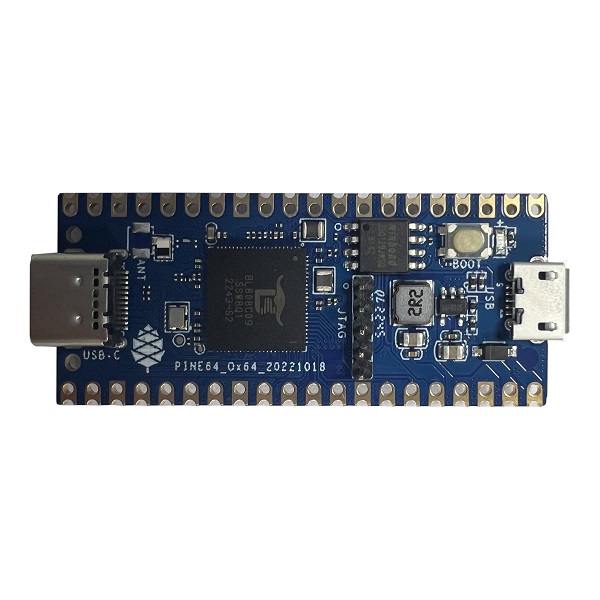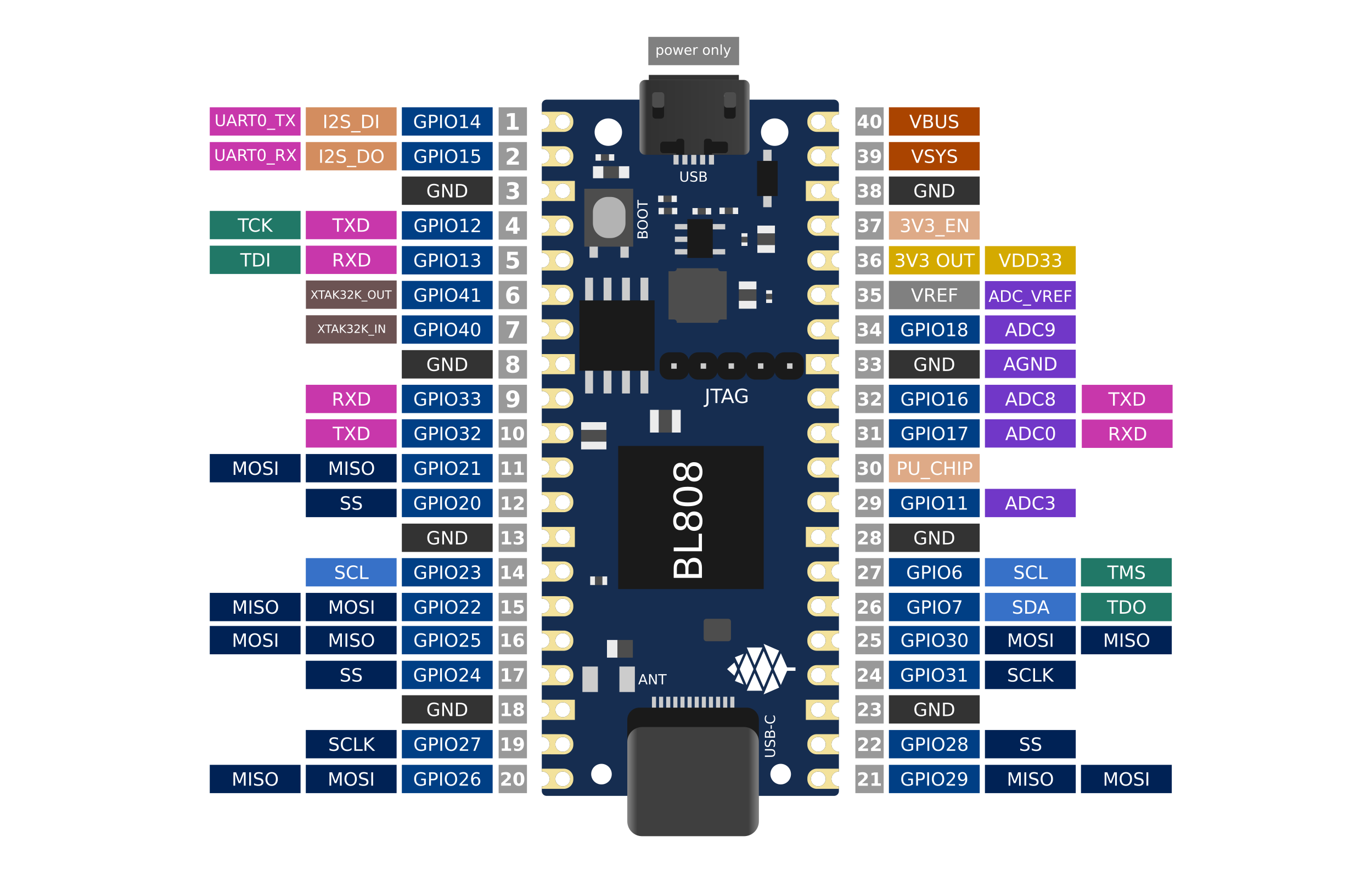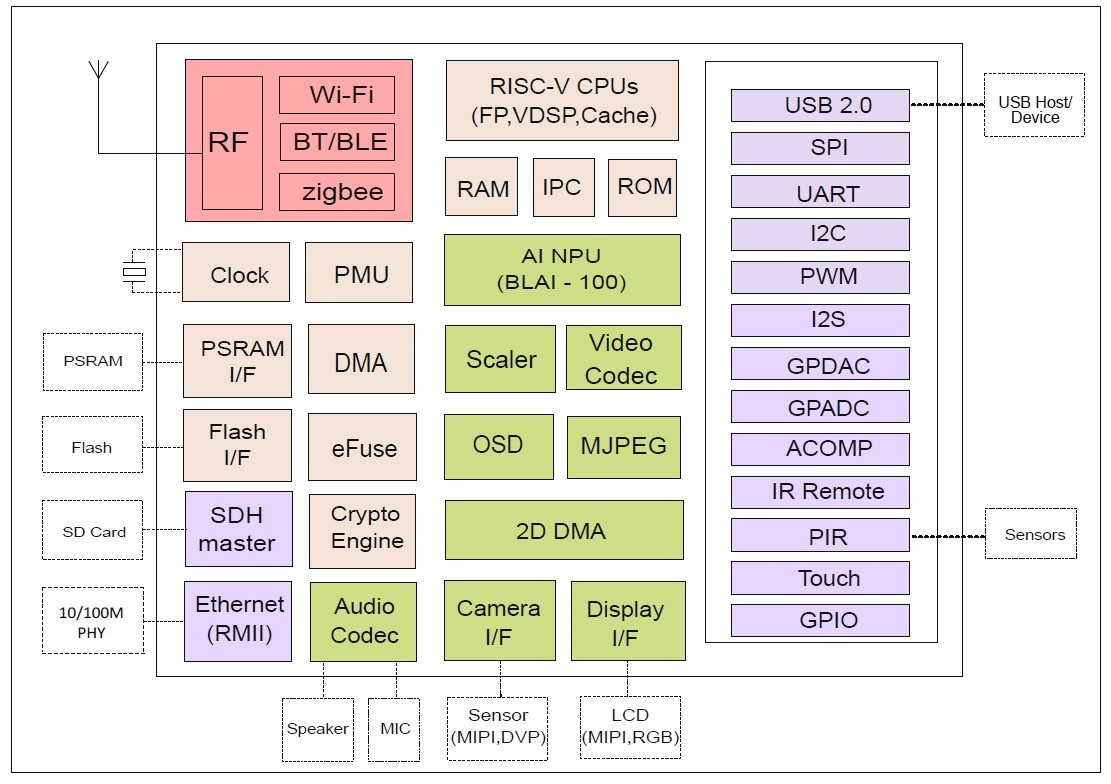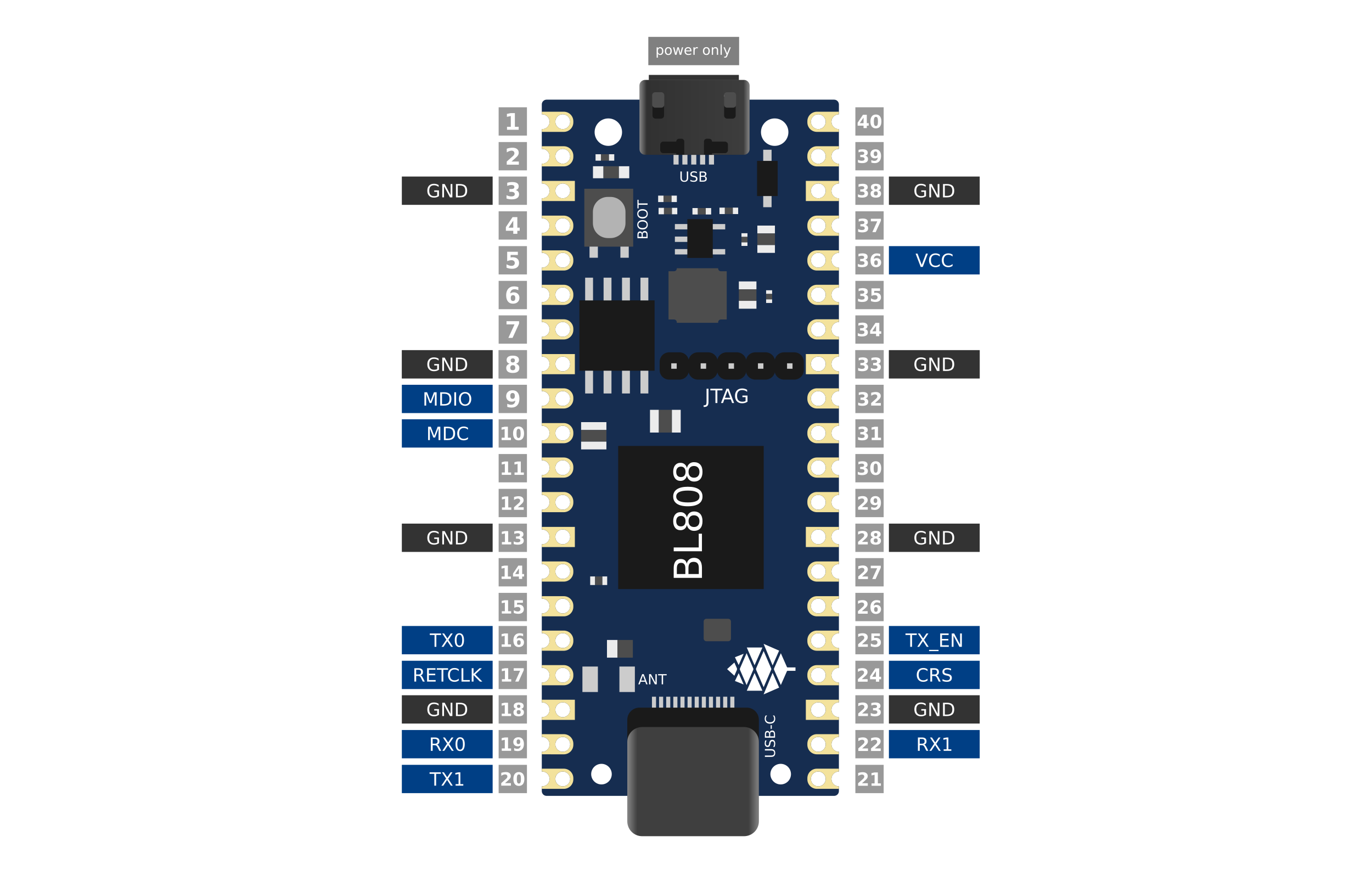Ox64
The Ox64 is a RISC-V based single-board computer based on the Bouffalo Lab BL808 RISC-V SoC with C906 64-bit and E907/E902 32-bit CPU cores supported by 64 MB of embedded PSRAM memory, and with built-in WiFi, Bluetooh and Zigbee radio interfaces. The Ox64 comes in a breadboard-friendly form-factor, has a microSD card slot, a USB 2.0 Type-C port, and many other peripheral interfaces for makers to integrate with sensors and other devices.
Software Releases
Quick Links to the Source of OS Images Build
There is a community effort to bring updated kernels, peripherals and buildroot - Lots of communication happening in the #ox64-nutcracker channel.
- buildroot bringing all the work below together with a bootable kernel and updated filesystem images for SD cards
- U-Boot and OpenSBI work by Smauel
- Kernel IRQChip, SDCard, and (WIP) USB by arm000, Alexander Horner and others
- OpenBouffalo Firmware low_load drivers by Fishwaldo and others
Original Linux Images provided by Bouffalo - Very basic alpha build which are only fit for board bring up and testing purposes.
- Linux for BL808
- Installation Instructions for Linux on BL808 (Chinese)
- Installation Instructions for Linux on BL808 (machine translated to English)
Toolchain:
- elf_newlib_toolchain/bin/riscv64-unknown-elf-gcc (Xuantie-900 elf newlib gcc Toolchain V2.2.5 B-20220323) 10.2.0
- linux_toolchain/bin/riscv64-unknown-linux-gnu-gcc (Xuantie-900 linux-5.10.4 glibc gcc Toolchain V2.2.4 B-20211227) 10.2.0
- cmake version 3.19.3
Software Development Kits
- BL808 MCU SDK
- BLDevCube Flashing Tool for Windows, macOS and Ubuntu x64
- Ox64 UART Flashing Guide, see the notes
- BL808 Demo Firmware: bl808_demo_event.bin, see the notes
- BL808 UART Log Firmware: whole_flash_data.bin, see the notes
- BL808 DVK Quick Start
- OpenSBI for BL808
- Rust Peripheral Access Crate (PAC) for BL808
- System View Description (SVD) for BL808
SoC and Memory Specification
Based on the Bouffalo Lab BL808
CPU Architecture
T-Head C906 480 MHz 64-bit RISC-V CPU:
- Supports RISC-V RV64IMAFCV instruction architecture
- Five-stage single-issue sequentially executed pipeline
- Level-1 instruction and data cache of Harvard architecture, with a size of 32 KB and a cache line of 64B
- Sv39 memory management unit, realizing the conversion of virtual and real addresses and memory management
- jTLB that supports 128 entries
- Supports AXI 4.0 128-bit master interface
- Supports core local interrupt (CLINT) and platform-level interrupt controller (PLIC)
- With 80 external interrupt sources, 3 bits for configuring interrupt priority
- Supports BHT (8K) and BTB
- Compatible with RISC-V PMP, 8 configurable areas
- Supports hardware performance monitor (HPM) units
- See here
T-Head E907 320 MHz 32-bit RISC-V CPU:
- Supports RISC-V RV32IMAFCP instruction set
- Supports RISC-V 32-bit/16-bit mixed instruction set
- Supports RISC-V machine mode and user mode
- Thirty-two 32-bit integer general purpose registers (GPR) and thirty-two 32-bit/64-bit floating-point GPRs
- Integer (5-stage)/floating-point (7-stage), single-issue, sequentially executed pipeline
- Supports AXI 4.0 main device interface and AHB 5.0 peripheral interface
- 32K instruction cache, two-way set associative structure
- 16K data cache, two-way set associative structure
- See here
T-Head E902 150 MHz 32-bit RISC-V CPU:
- See here
System Memory
- Embedded 64MB PSRAM
Board Features
Network
- 2.4 GHz 1T1R WiFi 802.11 b/g/n
- Bluetooth 5.2
- Zigbee
- 10/100 Mbit/s Ethernet (optional, on expansion board)
Storage
- On-board 16 Mbit (2 MB) or 128 Mbit (16 MB) XSPI NOR flash memory
- MicroSD, supports SDHC and SDXC (only on the 128 Mbit version)
Expansion Ports
- USB 2.0 OTG port
- 26 GPIO pins, including SPI, I2C and UART functionality, possible I2S and GMII expansion
- Dual-lane MiPi CSI port, located at USB-C port, for camera module
Audio
- Microphone (optional, on the camera module)
- Speaker (optional, on the camera module)
Board Information, Schematics and Certifications
- Baseboard dimensions: 51 mm x 21 mm x 19 mm x 3.5 mm (breadboard friendly)
- Input power: 5 V, 0.5 A through the microUSB or USB-C ports
Production version schematic:
- Ox64 Schematic 20221018 v1.1
- Ox64 PCB Component placement(ToP) 20221018 v1.1
- Ox64 PCB Component placement(Bottom) 20221018 v1.1
Prototype (dispatched to developers) schematic:
- Ox64 Schematic 20221007 v1.0
- Ox64 PCB Component placement(ToP) 20221007 v1.0
- Ox64 PCB Component placement(Bottom) 20221007 v1.0
Certifications:
- Disclaimer: Please note that PINE64 SBC is not a "final" product and in general certification is not necessary.
- Not yet available
Datasheets for Components and Peripherals
Bouffalo BL808 SoC information:
SPI NOR Flash information:
- GigaDevice 16Mb XSPI-Flash Datasheet
- GigaDevice 128Mb XSPI-Flash Datasheet
- Winbond 128Mb QSPI-Flash Datasheet (W25Q128JWSQ)
Power Regulator information:
MicroSD socket information:
Compatible UARTs when in bootloader mode
When the Ox64 is in bootloader mode, some UARTs are unable to communicate with it. When this is the case, utilities such as BLDevCube are unable to actually program the device. If you see "Shake hand fail" and an empty ack, and your device is in bootloader mode, then it is likely an incompatible UART.
The below devices have been tested and verified as working:
- Raspberry Pi Pico - running the following UART firmware (GP4 and GP5 are used for port 0, GP12 and GP13 for port 1)
- Compiled binary for Pi Pico and connectivity diagram is here
- ESP32 with CP210x - bridge the EN pin to ground to disable the ESP32 itself, and then connect the TX on the esp32 to 14 on the Ox64 and RX to pin 15. Note that only baud rate 115200 works, and this doesn't seem to work for everyone)
- Stand-alone CP2102 dongle works at 115200 baud. Brand used was HiLetgo.
- STM32F401 BlackPill - running the Black Magic Debug firmware
- STM32F103C8T6 BluePill - running Black Magic Debug.
- Some UART adapters based on the FT232H (note that the FT232RL does not work, and neither does the Pine 64 JTAG)
- Some CH340G based adapters work and some don't.
Resources and Articles
- A short video on how to connect to the Ox64, flash and boot
- Another video that covers soldering pins, connecting via Pi Pico and flashing Linux and U-Boot
- Step-by-step tutorial for how to build, flash and run Ox64
- First batch of Ox64 won't appear as USB serial port
- First batch of Ox64 tested OK with CH340C/G
- First thoughts on the (a)symmetry of Bouffalo Labs BL808 as in Pine64 Ox64
- The $8 linux computer (with picoprobe-rp2040 programming instructions)
- Building the Xuantie GNU Toolchain for Ox64 on macOS and Apple Silicon
Ox64 BL808 RISC-V SBC articles by Lup Yuen LEE:
- Booting Linux and (maybe) Apache NuttX RTOS
- Starting Apache NuttX real-time operating system
- Sv39 Memory Management Unit
- NuttX Apps and Initial RAM Disk
- UART Interrupt and Platform-Level Interrupt Controller (PLIC)
- Fixing the UART Interrupt and Platform-Level Interrupt Controller
- $8 RISC-V SBC on a Real-Time Operating System: Ox64 + NuttX
- Nim on a Real-Time Operating System: Apache NuttX RTOS + Ox64 BL808 SBC
Git repositories:
- Community made Arduino Core specifically for the Bouffalo Labs BL808 RISC-V MCU (initial development has been postponed until further notice)
Development Efforts
- Ox64 boots Linux successfully
- Brennan Ashton is porting Apache NuttX RTOS and OpenAMP (Asymmetric Multiprocessing) to BL808
- Phone Concept for BL808
Building
Start the building process cloning both the upstream Buildroot repository and the Buildroot Bouffalo overlay repository:
$ mkdir -p ~/ox64 $ cd ~/ox64 $ git clone https://github.com/buildroot/buildroot $ git clone https://github.com/openbouffalo/buildroot_bouffalo
Define an environment variable for the Buildroot Bouffalo overlay path:
$ export BR_BOUFFALO_OVERLAY_PATH=$(pwd)/buildroot_bouffalo
Change directory into the cloned Buildroot folder:
$ cd ~/ox64/buildroot
Apply the default configuration for Pine64 Ox64:
$ make BR2_EXTERNAL=$BR_BOUFFALO_OVERLAY_PATH pine64_ox64_defconfig
Use the `menuconfig` tool to adjust the build settings:
$ make menuconfig
Within `menuconfig`, configure the following:
- Select `Target Options`
- Enable `Integer Multiplication and Division (M)`
- Enable `Atomic Instructions (A)` using space key
- Enable `Single-precision Floating-point (F)`
- Enable `Double-precision Floating-point (D)`
- Select `Target ABI`, set it to `lp64d` and `press Exit`
- Select `Toolchain`, enable `Fortran support`, enable `OpenMP support`, and Save & Exit
Initiate the build process, but first make sure that your `PATH` variable contains no spaces. For Arch Linux distrubution you may also need to install extra-packages with `sudo pacman -S cpio rsync bc`.
$ make
Buildroot will output the needed files to the `~/ox64/buildroot/output/images` directory in about 1 hour, according to your computer processing resources and internet connection speed.
Flashing
This page explains how to flash an Ox64 board and a microSD card to boot the system. You will need a Linux computer, a serial UART adapter, the Ox64 board, and a microSD card.
Prepare images for flashing
Download the Ox64 images from the latest OpenBouffalo release. You may skip this step if you built your own images as per the instructions in the link:/documentation/Ox64/Software/Building/[Building] page.
$ mkdir -p ~/ox64/openbouffalo $ cd ~/ox64/openbouffalo $ wget https://github.com/openbouffalo/buildroot_bouffalo/releases/download/v1.0.1/bl808-linux-pine64_ox64_full_defconfig.tar.gz $ tar -xvzf bl808-linux-pine64_ox64_full_defconfig.tar.gz $ cd ~/ox64/openbouffalo/firmware $ xz -v -d -k sdcard-pine64_ox64_full_defconfig.img.xz $ mv sdcard-pine64_ox64_full_defconfig.img sdcard.img
Optional: create a combined SoC image
Use the following commands to combine _m0_lowload_bl808_m0.bin_, _d0_lowload_bl808_d0.bin_, and _bl808-firmware.bin_ into a single image. This is mainly useful for troubleshooting (e. g. when using DevCube v1.8.4 or later).
$ cd ~/ox64/openbouffalo/firmware # if you downloaded pre-built images # or $ cd ~/ox64/buildroot/output/images # if you built your own images
$ fallocate -l 0x800000 bl808-combined.bin $ dd conv=notrunc if=m0_lowload_bl808_m0.bin of=bl808-combined.bin $ dd conv=notrunc if=d0_lowload_bl808_d0.bin of=bl808-combined.bin seek=$((0x100000))B $ cat bl808-firmware.bin >> bl808-combined.bin
Check that you have the required files for flashing
$ cd ~/ox64/openbouffalo/firmware # if you downloaded pre-built images # or $ cd ~/ox64/buildroot/output/images # if you built your own images
$ ls -1 *808*.bin *.img
Expected files:
- `bl808-combined.bin` -- If you created the combined image.
- `bl808-firmware.bin` -- OpenSBI and UBoot DTB files. Runs on the D0 core.
- `d0_lowload_bl808_d0.bin` -- Startup code for the D0 core.
- `m0_lowload_bl808_m0.bin` -- Startup code for the M0 core.
- `sdcard.img` -- Kernel and root filesystem. Runs on the D0 core.
Set up your UART adapter
In this section we will configure and wire up a UART adapter in order to flash the Ox64. Choose one of the options below based on the hardware available to you; the first two are the most convenient since they minimise the number of times you will need to swap electrical connections.
Option 1: Raspberry Pi Pico
First, download the Raspberry Pi Pico firmware that allows it to act as a serial UART adapter:
$ mkdir -p ~/ox64/pico $ cd ~/ox64/pico $ wget https://github.com/Kris-Sekula/Pine64_Ox64_SBC/raw/main/uart/picoprobe.uf2
Put the Raspberry Pi Pico board into programming mode:
- Press the BootSel button
- Apply power by plugging the USB cable to PC
- Release the BootSel button
NOTE: As an alternative to pressing the BootSel button, you can also connect the probe point `TP6` (located on the bottom of the Pico board) to any ground point (e. g. pin 28).
The Pico will now appear as a USB mass storage device. Copy the `UF2` file to program it:
$ cp ~/ox64/pico/picoprobe.uf2 /media/<user>/RPI-RP2
Next, connect the Ox64 board to the Pico according to the following wiring diagram:
[cols="1,1,1"] |=== | Ox64 | PI PICO | /dev/tty
| uart0_Tx_GPIO14_pin1 | uart0_Rx_pin17 | ACM1 for flashing
| uart0_Rx_GPIO15_pin2 | uart0_Tx_pin16 | ACM1 for flashing
| Rxd_GPIO17_pin31 | uart1_Tx_pin6 | ACM0 for serial console
| Txd_GPIO16_pin32 | uart1_Rx_pin7 | ACM0 for serial console
| gnd_pin38 | gnd_pin38/3 |
| vbus5v_pin40 | vbus5v_pin40 | |===
With the Pico flashed and wired as per the instructions above, we have access to two of the Ox64's UART ports at the same time. This configuration eliminates the need to switch the physical connections for flashing or testing the system.
Reconnect the Pico to your computer's USB port and verify that we have access to all the serial ports we need:
$ ls /dev/ttyACM*
Expected result:
- `/dev/ttyACM0` connects to the D0 core's (i.e. Linux's) serial console
- `/dev/ttyACM1` is used for flashing (but also connects to the M0 core's serial console)
Option 2: STM32 Bluepill
The Bluepill is an affordable STM32 development board, based on the STM32F103C8T6 chip. We can program it to act as a USB serial adapter, just like we did with the Raspberry Pi Pico.
[NOTE]
The one catch is that you already need a serial adapter in order to program your Bluepill board. The good news is that you serial adapter does **not** have to be one from from the link:/documentation/Ox64/Further_information/Compatible_UARTs/[Compatible UARTs] list. These programming instructions have been tested with a FT232RL adapter (which, notably, is listed as _not_ supported on that list).
If you own an SWD-capable debugger (ST-Link, J-link, etc.) you can use that for programming the Bluepill as well, although instead of `stm32flash` console command you would be using https://openocd.org/[openocd] or other suitable software.
WARNING: Your serial adapter must use 3.3V logic levels.
Install software to flash Bluepill. For Debian-based systems just install package from repository:
$ sudo apt install stm32flash
For Arch Linux systems, use the AUR repository:
$ mkdir -p ~/ox64/bluepill $ cd ~/ox64/bluepill $ git clone https://aur.archlinux.org/stm32flash.git $ cd ~/ox64/bluepill/stm32flash $ makepkg -si
Download the https://github.com/r2axz/bluepill-serial-monster[Bluepill Serial Monster] firmware:
$ mkdir -p ~/ox64/bluepill $ cd ~/ox64/bluepill $ wget https://github.com/r2axz/bluepill-serial-monster/releases/download/v2.6.4/bluepill-serial-monster.hex
Put the Bluepill into programming mode:
- Set boot jumpers for booting from rom: Boot0=1, Boot1=0.
- Connect it to a USB-Serial adapter with A9 to Rx, A10 to Tx, GND to GND, 3v3 to Vcc.
- Apply power by plugging the USB cable to PC. Press the Reset button.
Find your USB serial adapter's device path with `ls /dev/ttyUSB* /dev/ttyACM*` (or similar); for the rest of this section we will refer to it as `/dev/tty[DEVICE]`. Upload the firmware:
$ cd ~/ox64/bluepill $ sudo stm32flash -w bluepill-serial-monster.hex /dev/tty[DEVICE]
After upload, set boot jumpers for boot from flash: Boot0=0, Boot1=0. Disconnect the USB serial adapter from both the PC and Bluepill board.
Next, connect the Ox64 board to the Bluepill according to the following wiring diagram:
[cols="1,1,1"] |=== | Ox64 | Bluepill | /dev/tty
| uart0_Tx_GPIO14_pin1 | uart0_Rx_A3 | ACM1 for flashing
| uart0_Rx_GPIO15_pin2 | uart0_Tx_A2 | ACM1 for flashing
| Rxd_GPIO17_pin31 | uart1_Tx_A9 | ACM0 for serial console
| Txd_GPIO16_pin32 | uart1_Rx_A10 | ACM0 for serial console
| gnd_pin38 | GND |
| vbus5v_pin40 | 5V |
|===
With the Bluepill flashed and wired as per the instructions above, we have access to two of the Ox64's UART connections at the same time. This configuration eliminates the need to switch the physical connections for flashing or testing the system.
Connect the Bluepill to your computer's USB port and verify that we have access to all the serial ports we need:
$ ls /dev/ttyACM*
Expected result:
- `/dev/ttyACM0` connects to the D0 core's (i.e. Linux's) serial console
- `/dev/ttyACM1` is used for flashing (but also connects to the M0 core's serial console)
- `/dev/ttyACM2` (unused)
Option 3: Generic UART adapter
image:/documentation/Ox64/images/ox64_pinout.png[Ox64 pinout,title="Ox64 pinout", 300, float="right"]
Check that your serial adapter is on the link:/documentation/Ox64/Further_information/Compatible_UARTs/[Compatible UARTs] list. You will (most likely) only have one serial interface available to you; unlike the previous options you will be using this same serial interface for both flashing and testing the system.
Find its device path with `ls /dev/ttyUSB* /dev/ttyACM*` (or similar); for the rest of this section we will refer to it as `/dev/tty[DEVICE]`.
You will also need a way of powering your Ox64. If your serial adapter has a 5V line, you can connect it to VBUS (pin 40). Otherwise, you can connect either the micro-B or the USB-C port on the Ox64 to any 5V power supply.
WARNING: Your serial adapter must use 3.3V logic levels.
Refer to the pinout image below. Connect your UART adapter as follows:
- RX -> UART0_TX / GPIO14 / pin 1
- TX -> UART0_RX / GPIO15 / pin 2
- GND -> any ground (e. g. pin 3)
Proceed with the instructions in the sections that follow, up to and including <<flashing_the_ox64>> and <<flashing_the_microsd_card>>, but replace all occurrences of `/dev/ttyACM1` with `/dev/tty[DEVICE]`.
Next, power off the Ox64 and re-connect your UART adapter as follows:
- RX -> TXD / GPIO16 / pin 32
- TX -> RXD / GPIO17 / pin 31
- GND -> any ground (e. g. pin 33)
Then, follow the instructions in <<booting_for_the_first_time>>, but replace all occurrences of `/dev/ttyACM0` with `/dev/tty[DEVICE]`. You should then have a working Linux system.
Download flashing tools
You have a choice of flashing software:
- DevCube: GUI-based closed source flashing tool
- CLI (`bflb-iot-tool`): command line open source flashing tool
DevCube installation
Download the latest DevCube flashing tool from BouffaloLab's website:
$ mkdir -p ~/ox64/devcube $ cd ~/ox64/devcube $ wget https://dev.bouffalolab.com/media/upload/download/BouffaloLabDevCube-v1.8.9.zip $ unzip BouffaloLabDevCube-v1.8.9.zip $ chmod u+x BLDevCube-ubuntu
If you did not create a link:#optional_create_a_combined_soc_image[combined image] you may need an older version of the DevCube. In that case, download v1.8.3 from one of the mirrors below:
- https://openbouffalo.org/static-assets/bldevcube/BouffaloLabDevCube-v1.8.3.zip
- https://hachyderm.io/@mkroman/110787218805897192[] > https://pub.rwx.im/~mk/bouffalolab/BouffaloLabDevCube-v1.8.3.zip
- https://we.tl/t-eJWShQJ4iF
- https://cdn.discordapp.com/attachments/771032441971802142/1145565853962735639/BouffaloLabDevCube-v1.8.3.zip
Verify that your copy of `BouffaloLabDevCube-v1.8.3.zip` matches the hashes below:
- SHA1: `0f2619e87d946f936f63ae97b0efd674357b1166`
- SHA256: `e6e6db316359da40d29971a1889d41c9e97d5b1ff1a8636e9e6960b6ff960913`
CLI packages installation
Install `bflb-iot-tool` using your preferred method of managing PIP packages. One option is to set up a Python virtual environment as follows:
$ sudo apt install pipenv # for Debian-based systems # or $ sudo pacman -S python-pipenv # for Arch Linux systems
$ cd ~/ox64/ $ pipenv install setuptools # install prerequisite of CLI flash tool $ pipenv install bflb-iot-tool # install CLI flash tool $ pipenv shell # activate virtual environment $ # bflb-iot-tool --help # return info about the tool
NOTE: Each time you open a new terminal window you will need to `cd ~/ox64/` and re-run `pipenv shell` to reactivate the virtual environment.
Flashing the Ox64
Put the Ox64 into programming mode:
- Press the BOOT button
- Apply power or re-plug the USB cable
- Release the BOOT button
CLI flashing method
Set up some environment variables to save typing them out later:
$ cd ~/ox64/openbouffalo/firmware # if you downloaded pre-built images # or $ cd ~/ox64/buildroot/output/images # if you built your own images
$ PORT=/dev/ttyACM1 $ BAUD=230400 # safe value for macOS, set to 2000000 for faster flashing on Linux
Finally, flash the Ox64. If you created a link:#optional_create_a_combined_soc_image[combined image] then run the command below:
$ bflb-iot-tool --chipname bl808 --interface uart --port $PORT --baudrate $BAUD --addr 0x0 --firmware bl808-combined.bin --single
Otherwise, run the following commands:
$ bflb-iot-tool --chipname bl808 --interface uart --port $PORT --baudrate $BAUD --addr 0x0 --firmware m0_lowload_bl808_m0.bin --single $ bflb-iot-tool --chipname bl808 --interface uart --port $PORT --baudrate $BAUD --addr 0x100000 --firmware d0_lowload_bl808_d0.bin --single $ bflb-iot-tool --chipname bl808 --interface uart --port $PORT --baudrate $BAUD --addr 0x800000 --firmware bl808-firmware.bin --single
If you get permission errors when running any of the commands above, run `ls -l /dev/tty[DEVICE]`, to find out which group is allowed to talk to serial ports and add your user to that group, with `sudo usermod -a -G [GROUP] $USER` (i.e. `dialout` for Debian or `uucp` for Arch Linux). Make sure you re-login. Running the commands as `root` is not recommended since this will make `bflb-iot-tool` create root-owned files in your home directory. You can now run `exit` from virtual environment.
=== BLDevCube flashing method
Open a new terminal window to run the DevCube flasher:
$ cd ~/ox64/devcube $ ./BLDevCube-ubuntu
Select chip [BL808], press Finish, and configure BOTH the [MCU] and [IOT] tabs as follows. When you switch between tabs double check that they still match the settings below:
[cols="~,~"] |=== |Interface |UART
|Port/SN |`/dev/ttyACM1`
|UART rate |230400 (safe value for macOS, set to 2000000 for faster flashing on Linux) |===
If you created a link:#optional_create_a_combined_soc_image[combined image] then you only need to use the [IOT] tab:
- Enable 'Single Download'
- Image Address [0x0], [PATH to bl808-combined.bin]
- Click 'Create & Download' and wait until it's done
- Close DevCube
Otherwise, start in the [MCU] tab:
- M0 Group[group0], Image Address [0x58000000], [PATH to m0_lowload_bl808_m0.bin]
- D0 Group[group0], Image Address [0x58100000], [PATH to d0_lowload_bl808_d0.bin]
- Click 'Create & Download' and wait until it's done
Then, switch to the [IOT] tab:
- Enable 'Single Download'
- Image Address [0x800000], [PATH to bl808-firmware.bin]
- Click 'Create & Download' again and wait until it's done
- Close DevCube
Erasing the microSD card
Make sure there are no signatures or partitions left, and overwrite the first sectors with zeroes. You can find the target device under `lsblk` command.
$ sudo wipefs /dev/[DEVICE] $ sudo wipefs --all --force /dev/[DEVICE]* $ sudo dd if=/dev/zero of=/dev/[DEVICE] status=progress bs=32768 count=1
Optionally you can zeroes the whole device:
$ sudo dd if=/dev/zero of=/dev/[DEVICE] status=progress bs=32768 count=$(expr $(lsblk -bno SIZE /dev/[DEVICE] | head -1) \/ 32768)
Flashing the microSD card
Insert the microSD card into your PC, locate its device under `lsblk` and write the image:
$ cd ~/ox64/openbouffalo/firmware # if you downloaded pre-built images # or $ cd ~/ox64/buildroot/output/images # if you built your own images
$ sudo dd if=sdcard.img of=/dev/[DEVICE] bs=1M status=progress conv=fsync
Booting for the first time
Power off your Ox64 and insert the microSD card.
Open a terminal window to connect to the D0 core’s (i.e. Linux’s) serial console:
$ minicom -b 2000000 -D /dev/ttyACM0
If you are using a Pico or Bluepill as your serial adapter, open another terminal window to to monitor the M0 core’s serial console (reminder: `/dev/ttyACM1` is the same port we previously used for flashing):
$ minicom -b 2000000 -D /dev/ttyACM1
Re-apply power to the Ox64.
On the main/D0 console (`/dev/ttyACM0`) you will see Linux booting up. When prompted, log in as `root` with no password. In case the SD card is missing or empty, you'll get a `Card did not respond to voltage select! : -110` error.
On the M0 console (`/dev/ttyACM1`) you'll see following messages until the sytem is fully loaded:
[I][MBOX] Mailbox IRQ Stats: [I][MBOX] Peripheral SDH (33): 0 [I][MBOX] Peripheral GPIO (60): 0 [I][MBOX] Unhandled Interupts: 0 Unhandled Signals 0
Once the system is running, the "MBOX" logs will abruptly disappear and you'll be able to manage the M0 multimedia core, i.e. wifi settings, etc. When prompted, type `help` to see available commands.
Connecting the Ox64 to your WiFi network
The simplest way to connect is to run the following command from the Linux console (i.e. `/dev/ttyACM0`):
$ blctl connect_ap <YourSSID> <YourPassword>
Wait for it to connect (if you're monitoring the M0 console on `/dev/ttyACM1` it should tell you when it's done), then run the following command from the Linux console:
$ udhcpc -i bleth0
Unfortunately the WiFi range leaves something to be desired. When you are performing the procedure above for the first time, move the Ox64 right next to your router. Once you are successfully connected, you can try experimenting with the maximum range.
For more information on using the `blctl` command, see https://github.com/bouffalolab/blwnet_xram[here].
Appendix
Adding Nuttx RTOS
In this section, we will set up our Ox64 to dual-boot both Linux and the NuttX real-time operating system. For more information see the https://nuttx.apache.org/docs/latest/platforms/risc-v/bl808/boards/ox64/index.html[official documentation].
First, write the normal Linux image to the SD card if you have not done so already. You can find the correct device under `lsblk`:
$ cd ~/ox64/openbouffalo/firmware # if you downloaded pre-built images # or $ cd ~/ox64/buildroot/output/images # if you built your own images
$ sudo dd if=/sdcard.img of=/dev/[DEVICE] bs=1M conv=fsync status=progress
Run the following command to re-read the partition tables. Re-inserting the SD card works too:
$ sudo blockdev --rereadpt /dev/[DEVICE]
Download the NuttX image:
$ mkdir -p ~/ox64/nuttx $ cd ~/ox64/nuttx $ wget -O ImageNuttx https://github.com/lupyuen2/wip-pinephone-nuttx/releases/download/bl808d-1/Image
Mount the boot partition and make the required modifications:
$ sudo mount /dev/[DEVICE]2 /mnt
$ sudo cp ImageNuttx /mnt/
$ sudo tee -a /mnt/extlinux/extlinux.conf <<EOF
LABEL PINE64 OX64 Nuttx
KERNEL ../ImageNuttx
FDT ../bl808-pine64-ox64.dtb
EOF
$ sudo umount /mnt
Mount the rootfs and make the required modifications:
$ sudo mount /dev/[DEVICE]3 /mnt
$ sudo cp ImageNuttx /mnt/boot/
$ sudo tee -a /mnt/boot/extlinux/extlinux.conf <<EOF
LABEL PINE64 OX64 Nuttx
KERNEL ../ImageNuttx
FDT ../bl808-pine64-ox64.dtb
EOF
$ sudo umount /mnt
Enjoy your new Nuttx booting option!





